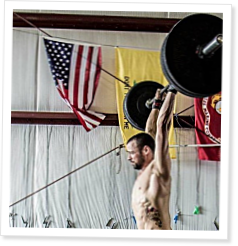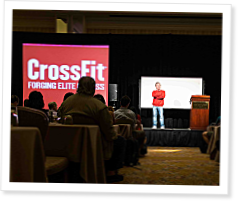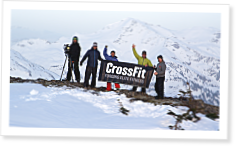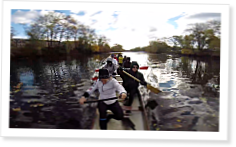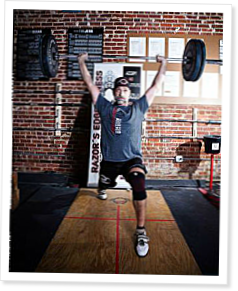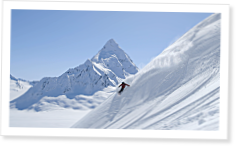by John Petrizzo DPT
“The idea that the amount of weight you can lift is irrelevant to your choice of squat and that lifting more weight in the low-bar back squat is not in fact building more strength, that it is somehow a parlor trick, is simply incorrect.”
Read More
var addthis_config = {"data_track_addressbar":true};
The idea that the amount of weight you can lift is irrelevant to your choice of squat and that lifting more weight in the low-bar back squat is not in fact building more strength, that it is somehow a parlor trick, is simply incorrect.
When examining which type of squat is the best choice for your training, it is important to understand why you are squatting in the first place. In nearly every scenario I can think of, we perform the squat to get stronger. I do not work with any competitive physique athletes or bodybuilders who train primarily for cosmetic purposes, and I’m guessing that for the most part, you don’t either. The type of squat performed by these trainees is none of my concern. What I am concerned about when programming my own training or that of my patients and clients is performance. Whether you are an athlete using the squat to enhance an aspect of your sport, an older person trying to maintain independence, or a competitor in a barbell sport, on some level you are squatting to improve your overall strength. With that in mind, doesn’t it make sense to perform the squat variant that allows you to lift the most weight and thus get stronger? If someone told you that you could increase your strength without any additional time in the gym or adjustments to your current programming, wouldn’t you be interested? What if the answer was as simple as sliding the bar a few inches down your traps? Before you consider that last point, allow me to explain why simply sliding the bar down your traps to just under the spines of the scapulae makes such a big difference in terms of what you are going to get out of your squat training. It seems obvious to me that if the reason you are squatting is to get stronger, you should choose the squat variant that allows you to lift the most weight. It has been my experience and the experience of many others that the overwhelming majority of people will be able to squat more weight using the version we call the “low-bar squat.” The idea that the amount of weight you can lift is irrelevant to your choice of squat and that lifting more weight in the low-bar back squat is not in fact building more strength, that it is somehow a parlor trick, is simply incorrect.Over the past several years I have heard many people make the argument that the low-bar squat doesn’t make you any stronger in comparison to other squat variants despite the fact that you can lift more weight and that ultimately it does not matter which squat variant you perform in the gym. While I have never heard a compelling rationale as to how that could be, the next few paragraphs are my attempt to respond to the notion that it doesn’t matter which squat variant you use in your training.Gravity, Moment, and the SquatTo understand why the low-bar squat allows for the use of more weight and thus provides a better overall strengthening effect than its other squat brethren, we must first have an understanding of the forces operating on the barbell and the body in barbell training. Any analysis of the squat must involve the concepts of leverage and moment and their relationship to the forces encountered during the execution of the lift, because these are the physical realities that we must deal with. Ultimately, they are what dictate how much weight we are going to be able to lift and therefore how much force we are going to be able to generate.Gravity is the constant force acting against the body and the barbell throughout all the barbell lifts (and everything else we do). Understanding the concept of gravity is the key in being able to efficiently and effectively analyze loaded human movement. Gravity can be defined as the agent that gives weight to objects with mass and causes them to fall to the ground when dropped. When examining the lifter-barbell system, gravity can be expressed as compression, tension, and moment.Compression is the force transmitted along an object that would make it shorter if the object were deformable. Examples of compression in barbell training include the body standing under a loaded barbell during the back squat or in the locked out position of the press. Gravity can also express itself as tension. Tension is the opposite of compression and occurs through the upper extremities while holding the barbell in the hands at the top of a deadlift or when hanging from a chin-up bar. (Please note that the examples of tension are simplified as they do not take into account the inherent compressive nature of the isometric muscular contractions that are occurring around the joints while standing at the top of a deadlift or hanging from a chin-up bar.) However, this may be a good time to point out that our skeletal structures inherently resist compressive forces while our soft tissues (muscles, tendons, ligaments, fascia, joint capsules, etc.) are our primary restraints against tensile forces.The final way that gravity expresses itself during barbell training is through moment or torque. Moment is defined as a force that tends to cause a rotation around an axis. A moment arm is the perpendicular distance (measured at 90 degrees) from the point of force application to the axis of rotation. Moment force is the force applied to a particular segment multiplied by the length of the moment arm. What this means is that essentially moment arms work as force multipliers. During barbell training the axes that will be subject to moment force will be the joints of the body, such as the hips, knees, and ankles during the squat and deadlift, and shoulders, elbows, and wrists during pressing movements.{pagebreak}When discussing moment arms and moment force in relation to barbell training, it is important to understand that there are certain moment arms that are inherent to all correctly performed movements. These are “good” moment arms, and we use them to create enough moment force to successfully overcome the loads we are trying to lift. However, if an exercise is performed incorrectly or with less than efficient technique, we can create unnecessary moment arms that require us to produce more force than we would otherwise have to in order to overcome a given load.
Extra work must be done on an out of balance bar as a moment arm (MA) develops between midfoot and bar. [From Starting Strength ©2011 Used with permission]
In physics, a force is said to do work when it displaces a mass, any given distance, at the point of application, in the direction of the force. Since we know that gravity operates only in a vertical line perpendicular to the Earth, any work performed against gravity must be performed in a straight vertical line away from the Earth. Furthermore, any deviation from vertical will create un-necessary moment arms that the lifter will have to overcome to complete the lift. Any motion that is not completely vertical during a barbell lift has a horizontal component and is therefore inefficient. In some cases, horizontal motion is introduced intentionally, which can be seen in primary exercises such as in the bar path of the bench press as well as when examining certain assistance exercises such as goodmornings (although the heavier the good morning, the more vertical the bar path becomes) or biceps curls. However, in the majority of the classic barbell lifts (Squat, Standing Press, Deadlift, etc.) that involves the simultaneous flexion and extension of multiple joints while standing on the ground, horizontal motion is detrimental to the proper and efficient execution of the exercise. Only the vertical distance the barbell travels can be considered in the work done against gravity irrespective of the amount of force used to overcome the horizontal displacement of the barbell.What this ultimately means for you is that if you are squatting, pulling, or pressing, a non-linear bar path is going to put you in a position in which you must generate more force to overcome the unnecessary moment arm created by the horizontal displacement of the bar. If you are squatting 400 pounds then you need to generate more than 400 pounds of force – say, “401” – to successfully complete the concentric portion of the movement. The caveat to that statement is that you are using a vertical bar path. If the bar path travels forward an inch or two during the ascent, you may have to produce 425 or 450 pounds of force to overcome the unnecessary moment arm you created and successfully complete the lift. A better idea would be to maintain a vertical bar path and use that 450 pounds of force generation to squat 445 rather than 400.When examining a correctly performed squat we can see how moment – or more specifically moment arms of different lengths – affect the movement. When standing at the top of a loaded squat, the bar will be balanced in a position directly over the middle of the foot. In the top position of the squat balanced over the mid-foot, the body experiences compressive forces through the spine and joints of the hip, knees, and ankles which are supporting the weight of the bar on the back. The mid-foot will be the position that ensures maximum stability and balance throughout the system for all barbell exercises that involve standing on the feet. When the weight is centered over the middle of your foot, a larger amount of force is required to perturb the position when compared to shifting the weight closer to the calcaneus or the metatarsophalangeal joints.{pagebreak}What this also means is that the mid-foot is the position that requires the least amount of force to maintain. Try shifting your weight forwards and back a little the next time you are standing on your feet. Depending on the direction you shift, you will immediately feel the anterior and posterior musculature of the lower extremities and trunk called into action to help you maintain that position. Compare this to a balanced position over the middle of the foot and see if you feel a similar response. In the top of the squat, the hips, knees, and ankles are experiencing very little to no moment because there is no significant horizontal distance between the loaded barbell and the axis of rotation (joints) through which the downward force that gravity imparts to the barbell acts. As soon as the hip, knee, and ankle joints unlock, moment begins to act along the back, thigh, and lower leg segments of the body as moment arms are created by the change in the distance of the joints from the vertical bar path through the mid-foot.The Squat and Its VariantsThere are several universal characteristics that can be seen in all correctly performed full squats regardless of bar placement. In the bottom position of the squat the bar will be directly over the middle of the foot, the trunk will be held in rigid thoracic and lumbar extension, the acetabulum will drop just below the level of the top of the patella, the feet will be flat on the floor, and the thighs will be in alignment with the feet. With this understanding, we can analyze how bar placement affects moment and leverage in the low-bar back squat and its variations. While I realize that all of these criteria may not always be adhered to during training and competition, from a safety and efficiency standpoint, I think they are pretty good rules of thumb to strive for. The diagnostic angles used to assess the squat are described as the back angle, formed by the torso in relation to the floor, the hip angle, formed between the torso and the thigh, and the knee angle, formed between the thigh and lower leg. When performing the low-bar back squat, there are certain universal characteristics observed regardless of anthropometry in order to facilitate a straight vertical bar path over the middle of the foot. In comparison to the front squat and high-bar back squat, the back angle will be more horizontal, the hip angle will be more closed, and the knee angle will be more open.
Diagnostic angles of the squat (left) and front squat (right). [From Starting Strength ©2011 Used with permission]
During the squat, the length of the moment arm along the back segment will always be the horizontal distance between the bar and the hips. Since gravity is the force that the lifter is working against and gravity always operates in a straight vertical line, we must therefore always measure the horizontal distance between the barbell and the axis working against it. Unlike the back segment, the femur and lower leg are bisected by the gravity vector created by our straight vertical bar path. For most people, this will create much smaller moment arms at the ankles and knees when compared to the hips. When using the low-bar back squat, the hips are placed in a position further behind the mid-foot, increasing the moment arm between the hips and the bar, therefore requiring more force generation by the posterior musculature of the hips and thighs (the hamstrings, gluteals, and adductors) to maintain the position of the barbell over the mid-foot and overcome the moment arm against the hips that is inherent in the properly performed movement. When examining the size of the moment arm placed along the hips of various barbell squats we see why the low-bar back squat works the posterior chain more effectively than any other squat variation.In contrast, the front squat will present with a completely different set of diagnostic angles and will therefore stress the muscles, tendons, and joints in a much different way. Due to the nature of the front squat and its bar placement being in front of the body on the anterior deltoids we can see the different effect this will have on our diagnostic angles. The back angle will be much more vertical, the hip angle will be more open, and the knee angle will be more closed. In this position we can see that the hips are much closer to the balance point over the middle of the foot, creating a smaller moment arm between the hips and the barbell. Therefore the front squat does not stress the posterior chain nearly as much as the low-bar back squat.It is for this reason that that front squat does not allow for the use of as much weight as either the high-bar or low-bar versions of the back squat. In addition to the position of the hips relative to the point of force application, the knees are further away from the balance point. For this reason, the front squat places more rotational stress on the knees when compared to the low-bar back squat. Finally, there will be a new moment arm created that we do not see in the low-bar or high-bar back squats – the moment arm between the bar and thoracic spine. This means that the thoracic extensors will have to work harder during the front squat in order to facilitate efficient force transmission and a vertical bar path.{pagebreak}The high-bar version of the back squat is essentially the middle-child of the low-bar and front versions of the movement. The high-bar movement will not require a torso angle as vertical as the front squat, but it will not be as horizontal as the low-bar version. What this means is that ultimately, for most people, the high-bar will allow for the use of more weight than the front squat, but not as much as the low-bar. All of this is dictated by the position that the joints must accommodate to facilitate a bar path over the middle of the foot and the resultant moment arms that occur secondary to the movement pattern. The high-bar version is the average of the front squat and the low-bar back squat. Putting it All TogetherDespite the fact that most of us would agree that the majority of people can squat more weight using the low-bar version of the lift, there are those who argue that there is really no difference in how each version of the movement works the musculature, and that ultimately the fact that more weight can be lifted in the low-bar position is not an indicator of improved strength relative to the other squat variants. However, a simple analysis of the nature of force production and the muscle actions required to successfully overcome any given load quickly shows why this assessment is inaccurate.When the muscles are exerting force against an external resistance, there are three possible resulting muscle actions that can take place. Eccentric muscle actions occur when the muscles lengthen under a load. It is what occurs in the quadriceps when you are stepping down the stairs or, more pertinent to this article, what happens to the quadriceps and muscles of the posterior chain during the descent on the squat. During an eccentric muscle action the muscular force is always less than the external force they are working against. This is always true, because if it weren’t, your muscles would cease to lengthen under the external resistance. They would either stay the same length or get shorter. If the force produced by the muscles equals the external force, no change in muscle length will occur and the muscle action is referred to as isometric. Finally, when the muscular force is greater than the external force, the resulting muscle action is referred to as concentric and the muscles will shorten in length.Now that we have that out of the way, it is important to understand that every correctly performed squat that starts at the top, whether it is low-bar, high-bar, or a front squat, involves both eccentric and concentric muscle actions. If we know that the low-bar back squat forces the hips to work against a longer moment arm, and that this longer moment arm enables us to generate more moment force, which ultimately allows us to lift more weight, how is it possible that the low-bar back squat is not making us stronger in comparison to the other squat variants we have been discussing?If we take a hypothetical lifter who trains all three movements and can low-bar squat 400 pounds, high-bar squat 375 pounds, and front squat 315 pounds, then by definition, in order to successfully complete the concentric portion of the lift, he must generate the greatest amount of force while squatting 400 pounds in the low-bar position in order to overcome the load. Put another way, the low-bar position forces him to generate “401” pounds of force to complete the lift, while the high-bar and front squat versions would only require a minimum of “376” and “316” pounds of force generation respectively. Which do you think will make our hypothetical lifter stronger?What is strength? Strength is force production against an external resistance. The greater the external resistance, the greater the force production necessary to overcome it. The squat variation that allows for the most weight to be lifted, and which therefore requires the greatest amount of force production, is the squat variation which provides a greater systemic stress and overall higher strength training stimulus.The Muscles ThemselvesThe low-bar, high-bar, and front squat all produce a unique set of moment arms at the respective joints that serve as the axis of rotation in the squat. While we have detailed the impact that these moment arms have on force production in a general sense, we have not yet discussed how each squat variant impacts the musculature and its mechanics on a more local level.{pagebreak}The sarcomere is the basic contractile unit of skeletal muscle. Sarcomeres are composed of long, fibrous proteins known as actin and myosin that slide past each other when the muscles contract and relax. It is theorized that they are able to generate contractile force and slide past each other due to the formation of cross-bridges between actin and myosin. This is known as the Sliding Filament Theory of muscle contraction. The Length-Tension Relationship of skeletal muscle dictates that the contractile components of the muscle cannot generate force as efficiently if the sarcomeres within the muscle fiber are either excessively lengthened or excessively shortened. If the muscles are excessively lengthened, the actin-myosin cross-bridges are spread too far apart to efficiently overlap to generate force. If the muscle is excessively shortened, excessive overlap between the actin and myosin filaments prevent effective force production beyond their already shortened length. What this means is that a muscle produces force most efficiently when the muscle belly is at its “resting” or mid-range length.
Active length-tension curve of a sarcomere at different sarcomere lengths At point (A), actin filaments overlap myosin filaments to the point where the ultimate number of cross-bridge attachments is reduced. At points (B) and (C), actin and myosin filaments are in such a position that an optimal number of cross-bridge attachments can occur. At point (D), the sarcomere is lengthened to the point that actin filaments are out of the range from the myosin heads so that no cross-bridge attachments are possible.
Earlier it was stated that relative to either the high-bar or front squat, the low-bar squat would always produce a more horizontal back angle, a more closed hip angle, and a more open knee angle. Given this fact, the varying joint angles produced at the hip and knee by the different squat positions create different muscle belly lengths between the joints involved. If the joints are in different positions, the muscles that move them will be slightly longer or shorter depending on the joint relationships in the particular squat variant.Additionally, the varying joint angles produced at the hip and knee by the different squat variants also change the muscle’s Angle of Pull on the bones with which they interact. A muscle’s angle of pull can be defined as the angle at which the axis of a muscle belly generates tension relative to the long axis of the bone to which it is attached. The most efficient angle for a muscle to pull on the bone is 90 degrees. However, most muscles pull on bones at far less than a 90-degree angle. The nearer to 90 degrees the angle of pull is, the more mechanically efficient the muscle’s leverage on the joint. Being that all three of the squats we are discussing produce their own unique set of joint angles, we also know that the involved musculature will have a slightly different angle of pull on the skeletal structures to which they transfer force in order to create movement.An example of an anatomical feature that improves our musculature’s angle of pull is the patella and its impact on quadriceps function. The patella, being embedded in the quadriceps and patellar tendons, functions to increase the angle of pull that the quadriceps are able to use on the tibias to produce knee extension. By shoving the tendon more forward of the tibial tuberosity than it would be without it, the patella improves the quadriceps’ angle of pull. We can therefore conclude that because of the varying muscle belly lengths and angles of pull produced by the differing joint angles, the relationship between the actin and myosin cross-bridges and the muscles’ attachment mechanics must also be different across the varying squats. The undeniable fact is that not all squat variants are the same. The same musculature may be working to produce hip and knee extension while maintaining a rigid spine, but each squat variant uses the musculature with different levels of efficiency.{pagebreak}An obvious example is the hamstring. Do the hamstrings contribute to hip extension in the front squat? Of course they do, because that is their job, but if we look at the bottom position of the front squat we can see that the more open hip angle and more closed knee angle produces a shorter hamstring belly when compared to either the high-bar or low-bar versions of the movement.
Differences in angle of pull by the hamstring muscle group on the tibia and fibula occurs secondary to the varying hip and knee angles produced by the low-bar back squat (A) and the front squat (B). Note that the angle of pull of the hamstrings on the tibia and fibula in the low-bar back squat is closer to 90 degrees than the more acute angle of pull of the hamstrings on the lower leg demonstrated in the front squat. [Figure modified from Starting Strength ©2011 Used with permission]
A shorter hamstring belly produces more overlap between the cross-bridges and ultimately less ability to efficiently produce force and contribute to hip extension, and the more closed knee angle in the front squat reduces the efficiency of the angle of pull of the hamstrings on the tibia – the angle of pull is close to 90 degrees in critical bottom position of the low-bar squat, and nowhere near 90 degrees in a front squat. This is just one example of how the Length-Tension Relationship and Angle of Pull of the musculature vary between the different squat variants. Similar analyses can be done for all of the involved musculature.Final Thoughts The bottom line is that the position of the barbell on your back or shoulders is what will ultimately dictate the position the joints must occupy to keep the system in balance, the length of the moment arms the joints will use to generate moment force, and on a smaller level, the interaction between the actin and myosin cross-bridges that are responsible for muscular contraction. So yes, this stuff does matter.When examining which type of squat makes the best use of your training time, you must understand the physical realities of your situation. When examining your own training programs or the programs you create for others, shouldn’t you be able to answer why you are doing what you are doing? This article is my attempt to answer the “why” of the low-bar back squat. My question to you is this: if you are going to be squatting with a barbell, and you are squatting to get stronger – to produce more force against an external resistance, then why not just squat in a position that allows you to lift the most weight, and therefore generate the most force? Given no anatomical reason that precludes the use of the low-bar version of the lift, I don’t see how the use of either the high-bar or front squat is a productive use of training time if your goal is general strength development.The low-bar back squat allows for the use of the most weight and therefore provides a better overall strengthening effect than any other version of the movement commonly practiced with a barbell. The movement pattern places the joints in a position that both requires and permits the involved musculature to generate more force to overcome the moment arms inherent in the movement. Greater force production from the involved musculature equates to more weight lifted, which leads to more overall strength development. Sometimes things are just not as complicated as they are made out to be.
John Petrizzo is a Physical Therapist, Starting Strength Coach, and a full-time faculty member in the Exercise Science Department at Adelphi University. John has a B.S. in Exercise Science from Hofstra University where he was a member of the football team and holds a Doctorate in Physical Therapy from the New York Institute of Technology. He has worked in the fitness industry since 2006 in a variety of roles and settings and has helped many patients and clients achieve their health, fitness, and sports performance goals through barbell training. In 2012, John began competing in powerlifting.
